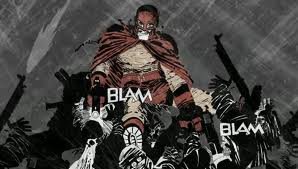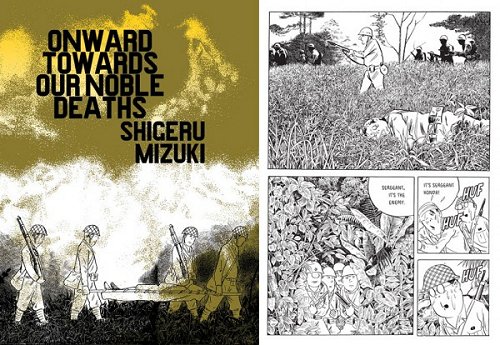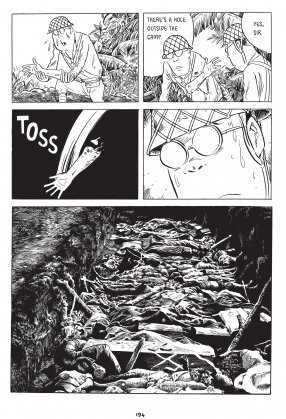 |
|
Miracle Pictographs
|
February 2012
These tights are not regulation, Robin!
Holy Terror (Legendary 2011), Onward Toward Our Noble Deaths (Drawn & Quarterly 2011, Originally printed in Japan 1973)
I've got a thing for war movies, partially because of their core contradiction. War stories are
meant to chronicle the experience of something that is especially incommunicable.
All entertainment is imitating something that is better experienced, but most people can describe
what falling love feels like, or describe the beauty of the natural world, or even, given time, find
a way to describe the first time they looked in their child's eyes.
I recently dug through an archive of interviews with aged WWII vets for an independent research
project. Their descriptions of combat are tricky in their vagueness. "A nightmare." "I've never
experienced anything like that." "You just can't imagine it. No one can."
A Vietnam vet once told me that Saving Private Ryan was "just like the real thing." Really? It
was all cleverly choreographed, set to music and the men involved, even the Oscar-winning
actors, didn't believe they could die.
But moral, responsible entertainment creates meaning out of the overwhelming, and that has to
include war. Stephen Crane had never seen battle at the time he wrote The Red Badge of
Courage. He had a fairly profound influence on the way people remembered the Civil War and
the sacrifice of its soldiers.
Memory, recall and secondhand construction are tricky even for excellent writers who are vets,
like Tim O'Brien. Stories are the closest I could get without signing up for Afghanistan -- and
while I admire and respect those who do serve, that's not in the plan.
So Holy Terror should be able to, despite a somewhat silly premise, communicate a sense of the
overwhelming horror of a terrorist attack to a public who seek meaning out of the brutality they
see on the news.
It should. Too bad reads like an eighth-grader's version of a Michael Bay movie.
Frank Miller's work has always been about style, not substance. It worked in 300, despite the
silliness of the story. It worked in Sin City. Both were about the experience, not the content.
Now his masturbatory exposition and hyper-macho style are being applied to… Batman vs. Al-Qaeda.

Let's get one good thing established: Frank Miller's artwork is highly stylized, experiential and
cool. The opening sequence, in which a homemade bomb sends thousands of nails flying through
the air, creates a great effect, the stark black shapes of nails dark and sharp. It's a shame he
wastes some cool art on his horrid writing.
The Batman figure is a hero named The Fixer, chasing a cat-suited female thief. In the true
manner of Batman and Catwoman, their tussle is erotically charged, at least until they are caught
in the blast of Al-Qaeda's nail-bomb attack.
A transparent version of Commissioner Gordon attempts to control the police force and get them
organized against the terrorists, to no real avail. The true battle is fought by the Fixer with the
terrorists in the basement of the biggest mosque in "Empire City." No political implications there
. . .
And the battle is fought against . . . a raging Irish stereotype, an IRA leftover who has taken up
with Al-Qaeda, and a bunch of faceless burka-clad assassins.
Let's sample some of the amazing quotes here. From a terrorist villain: "Your beheading will
make a b**** of a video. Maybe we'll do you nude, that'd put the fear of Allah into you." (Yes,
in addition to its other crimes, this comic spliced a comma.) From our heroes: "Give my regards
to those seventy-two black-eyed virgins, you son of a b****." "They're killing the police
commissioner tonight on my order. He needs killing. I've been on his trail for months. He's
rotten. The mayor'll haul out a bushel basket of kids. Family is always the excuse."
After the Fixer jumps in, guns blazing, and sets off the poison gas that Al-Qaeda intended for the
denizens of the city, Miller treats us to a description of a terrorist's death. "His nose and ears and
eyes start bleeding. He keeps scratching. He pulls his hair out in clumps. He wrenches his right
eye from his socket."
Holy Terror is a truly putrid work, but one might laugh it off until the attempt to be topical in the
closing sequence, in which the Commissioner Gordon figure lays awake night after night. The
closing line is "No wonder they call it terror."
Right. Come for the gore, stay for the moral. At that point, the reader reaches the unsettling
realization that Miller never meant for this to be a parody.
Holy Terror does not mean anything. It does not teach anything. Should we take comfort in the
fact that Batman can save us from Al-Qaeda?
Audiences like villains in the vein of the Joker, because they allow us to project a set of fears and
horrors into a fantastical figure, and in the Aristotelian mode, feel purged of these fears when the
evil figure is defeated.
We should never mistake the investment we, as audiences, create with archetypes like Batman
and the Joker with the investment we, as audiences, make with the near-biographical figures of
Saving Private Ryan and Platoon. To conflate the two is to disrespect veterans and mistake the
foggy morality of war and the cost of personal sacrifice for too-clear comic-book morality.
In Miller's world, a Marine whose body armor still couldn't keep shrapnel out of his leg should
be equated with a woman who runs all over rooftops at night in a leather catsuit. Jihadis sniping
at soldiers, bombing with salvaged equipment, cut off and misinformed by their oppressive
society, are faceless ninja thugs in the vein of a Chuck Norris movie.
His world must be a very strange place.
Tim O'Brien said, "If at the end of a war story you feel uplifted, or you feel that some small bit
of rectitude has been salvaged from the larger waste, then you have been made the victim of a
very old and terrible lie."
That's why Onward Toward Our Noble Deaths is so wrenchingly effective. It is largely based on
Shigeru Mizuki's experience as a foot soldier on New Britain in New Guinea, fighting for the
Japanese side during World War II.
Mizuki starts with and returns to a recurring theme -- a prostitute's lament, roughly translated,
into "Why am I stuck working this sh*tty job? No way out, all for my parents . . ." It is adopted
by the soldiers, as if to reflect their cheap, used status. In the vein of so many true war stories,
once life becomes cheap, few can keep hold of it. By the end, they've lined up to throw their
lives away.

Unlike the US, which took seventy years to recognize comics as their own art form, Japan has
always valued the graphic novel as its own art form, and Mizuki was a revered artist long before
he began to publish his war memoirs.
Mizuki follows a massive cast, whose faces adorn the opening flaps with their names. Americans
will no doubt have a hard time keeping Nogami, Kawakita, and Okuyama straight from
Kageyama, Kaneda and Kobayashi, so the roll call is helpful.
Mizuki's art is beautifully versatile. The figures are spare and cartoonish, but the backgrounds
and battle scenes are lush and realistic, a variegated bevy of crosshatching that creates texture in
simple black and white.
The only frustrating thing about this comic -- and boy is it frustrating -- is that Drawn and
Quarterly has not Westernized the format. You must read everything from right to left, and that
includes word bubbles on the page! It wouldn't have been hard to mirror everything in the print;
other famous manga, like the works of Osamu Tezuku, has been reprinted in Western format and
it doesn't hurt the virtue of the work.
The soldiers spent their initial time fighting malaria and dengue fever, waiting on the Allied
invasion, standing in a seventy-deep line for a house of prostitution, searching for food. One
soldier is eaten by crocodiles as he tries to hunt down a wild pig to eat on the Japanese New
Year's; another goes fishing with grenades and chokes on the fish.
Under the command of a young officer, Tadokoro, who has romanticized combat, the men
receive the order for a banzai charge. Tadokor's glorious suicide charge fizzes out; the non-commissioned officers all back down and Tadokoro himself is only wounded; he has to ask his
men to leave him to commit suicide.
The soldiers staggering back from their suicide run meet with another twist of fate. Their deaths
have already been reported, and they will not be allowed back in the ranks to besmirch
Tadokoro's reputation -- even though he was countermanding orders when he ordered his
precious banzai charge.
A doctor, Ishiyama, seeks to argue over the men's fate with one of the superior officers, Kido.
After an angry, but futile stand arguing the value of human life, the doctor takes his own life
rather than be sent back into combat.
Kido interviews the two minor officers who failed to follow through on the suicide charge, until
both are shamed enough to agree to suicide. They weep and tear up their letters from their
mothers and wives. The art leaves them holding katanas with pistol-wielding superiors behind
them. In the next panel, Mizuki transitions to his realistic style, showing the spare Japanese
markers for their graves.
In the end, after the cast is slaughtered in another banzai charge, Mizuki pans out from one dead
soldier over fields of the butchered Japanese, his art again shifting from cartoonish to realistic,
breaking through, transforming art and experience together, communicating the incommunicable
horror.

As he says in his afterword, "What vain words these are, the dead have no mouths to tell."
Miller has said that he meant Holy Terror to be a deliberate propaganda piece, although he
seems to flounder for any greater meaning. Onward shows the danger of any thinking like that.
Japanese society in Onward has lionized suicide and "honorable combat" to the point that lives
are worth less than the notion that deaths fit the meaning of "honor."
Suicide and "honorable death" are still big factors in the psychology of the wars we fight today,
and I can only wish that pieces like Onward got the attention that a high-profile artist like Miller
gets. Maybe it would make a difference.
Continued Below Advertisement
Read more by Spencer Ellsworth